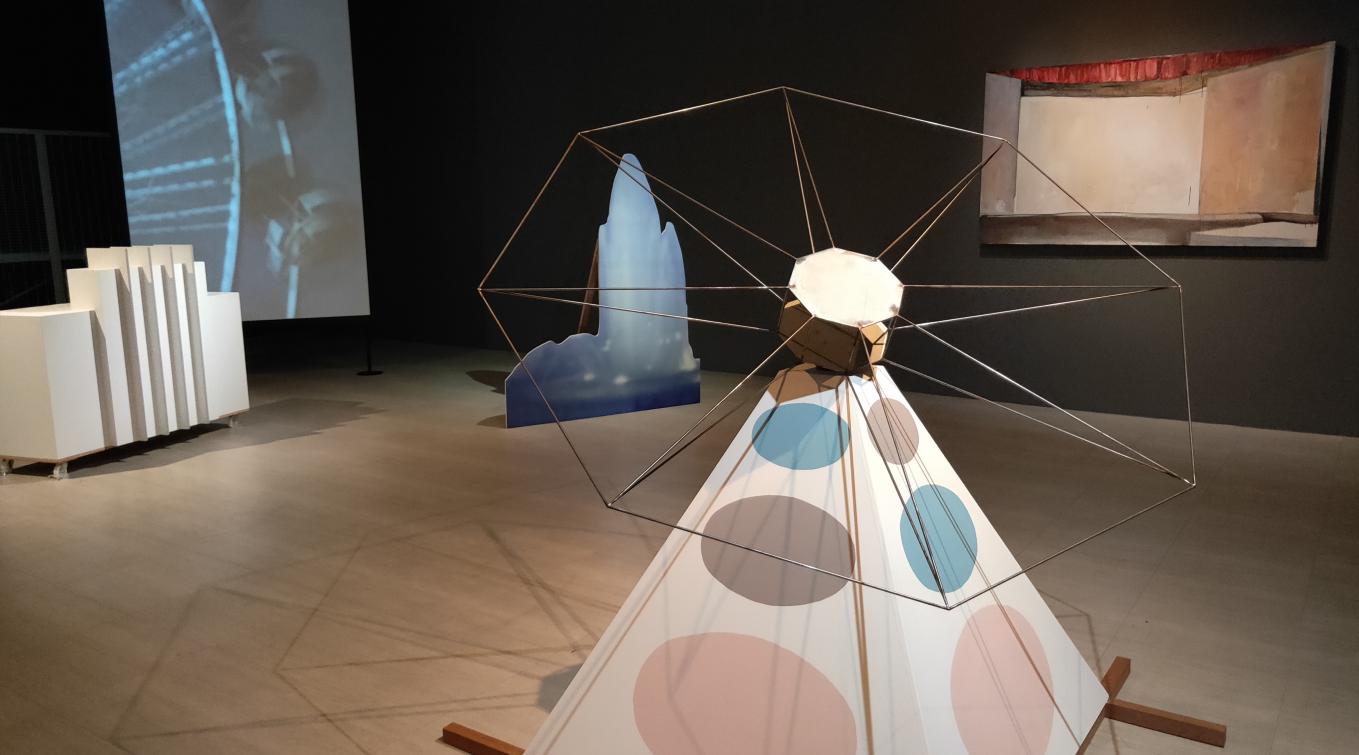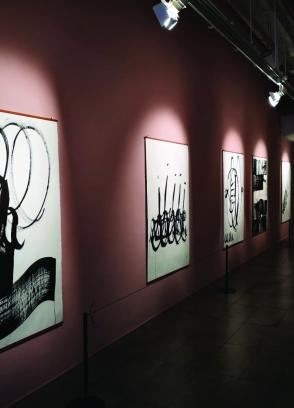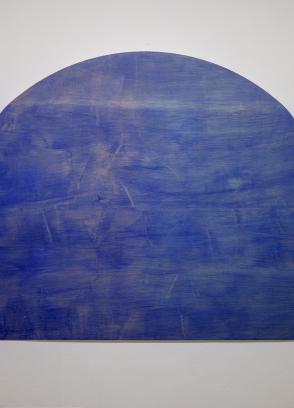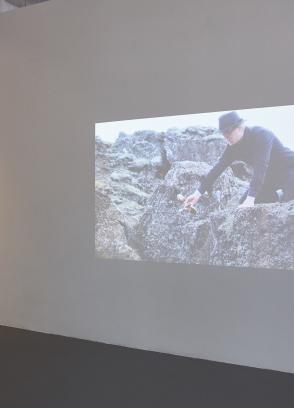Hilmi Johandi, An Exposition, 2018. Oil on canvas, three-channel video, digital print on vinyl sticker mounted on wood, synthetic polymer paint, plywood and mild steel. Dimensions variable
by Andrea Tan Shi Qi, Diploma in Fine Arts Level 3 (2019)
“Reflection, thought and identity. This exhibition gave me some degree of reflexivity, the spaces I find myself in, to reconsider what I think I knew and what made me realise that the idea of identity is not exclusive to humans or living things, and identity may not necessarily be defined by specifics. ”
Reflection, thought and identity. These were the three words that subconsciously made their way to my mind when I was going through the gallery spaces for the President’s Young Talents 2018 exhibition. I was in a state of constant reflection and thought throughout my visit, and I think that says quite a lot about the quality of work by the participating artists.
I begin with Zarina Muhammad’s Pragmatic Prayers for the Kala at the Threshold. Although I was a little overwhelmed with all the little objects and sculptures, and the seemingly disorderly manner in which elements of the installation were placed, I felt comfortable and at ease. There was something about the space that felt familiar, and I could not quite place my finger on it, until I saw a structure that held jasmine flowers and joss sticks, and realised it was the familiarity of scents that I grew up with during religious practices.
Now, I am neither a professional reviewer nor critic but I have to say, I was pleasantly surprised by the opening performance. The music felt alive, and if I were to describe it, it seemed like a young child playing it, which is actually strange to me, considering the videos and spatial atmosphere felt rather solemn, delicate and ritualistically sacred.
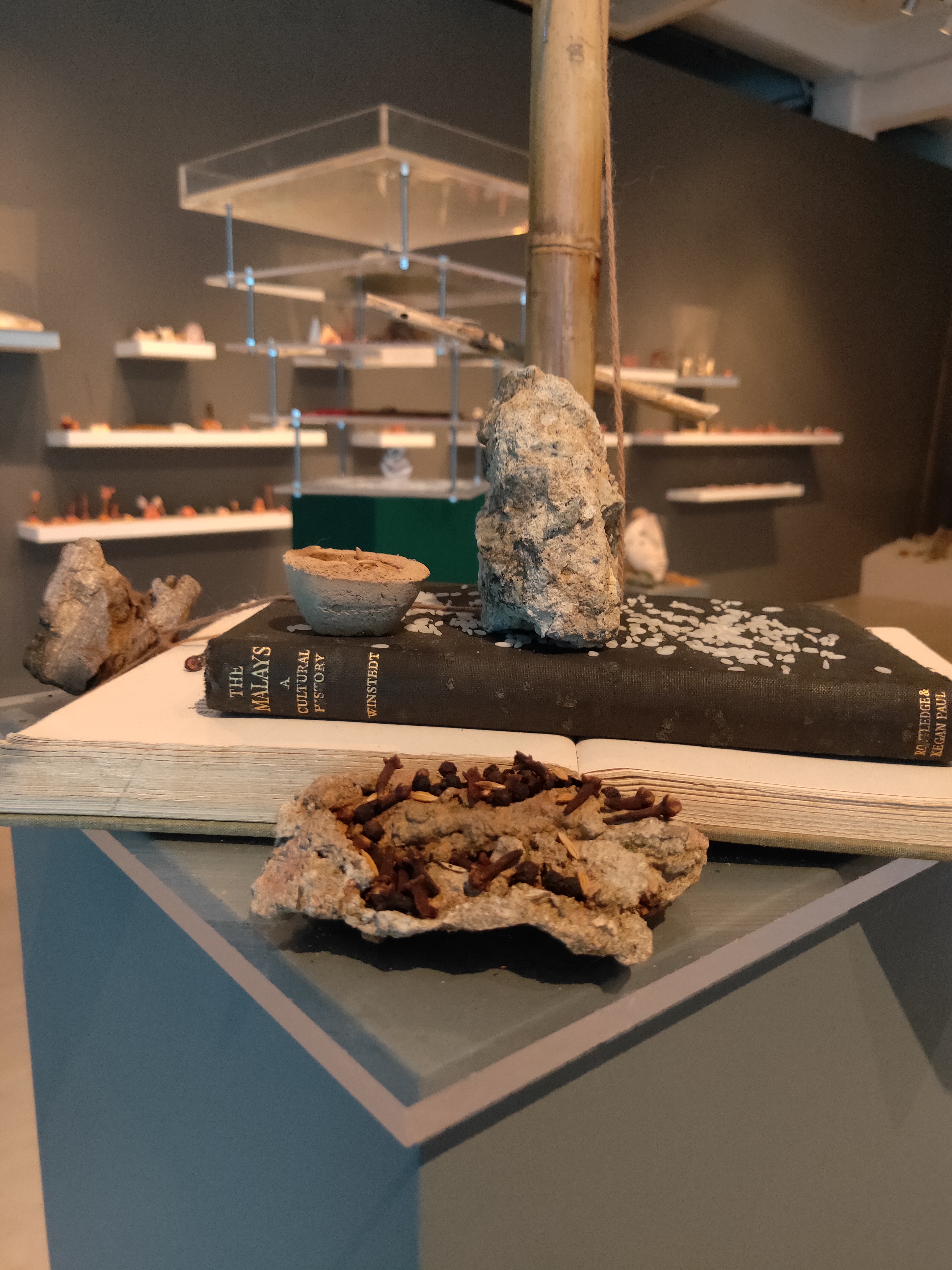 Zarina Muhammad, Pragmatic Prayers for the Kala at the Threshold, 2018. Bamboo, sandalwood, clay, stone, turmeric powder, sandalwood powder, saffron, nine grains and spices, rose water, incense, glass jars and paper. Dimensions variable
Zarina Muhammad, Pragmatic Prayers for the Kala at the Threshold, 2018. Bamboo, sandalwood, clay, stone, turmeric powder, sandalwood powder, saffron, nine grains and spices, rose water, incense, glass jars and paper. Dimensions variable
With the dimmed room, warm lights, a congregation of performers and audiences, it felt like a gathering of high importance, the sound of steady percussion and gentle gamelan resembling what I used to hear as a child during mass prayers in Buddhist temples. It was also an interesting contrast, the somewhat sombreness of the videos projected on the walls behind the performers, against the chill and friendly vibes exuded and communicated by the performers to the audience present.
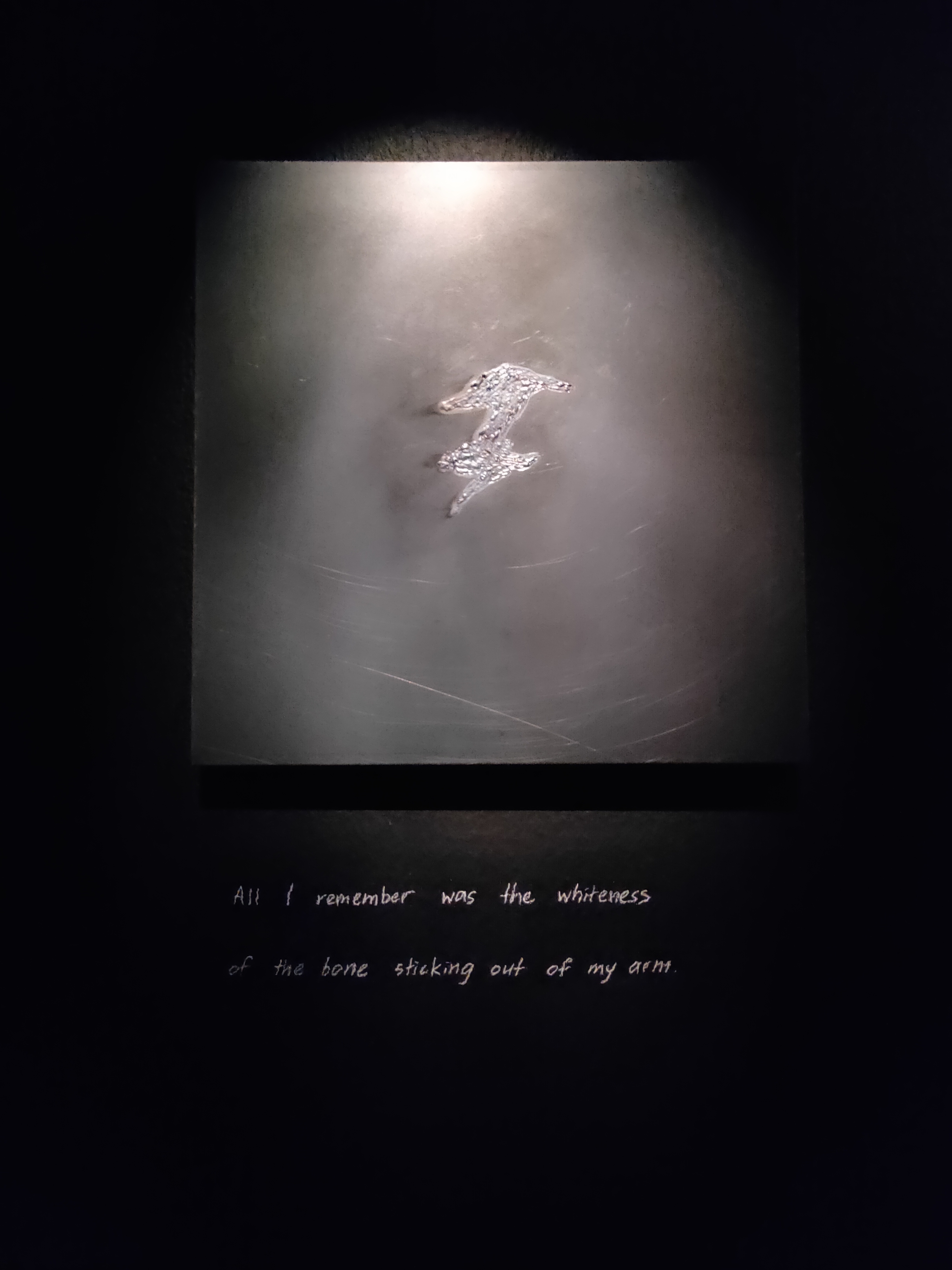 Yanyun Chen, The scars that write us, 2018. Charcoal, chalk, gold leaf. Steel plates, 30x30cm (set of 10), steel sheets, 180x80cm (set of 6)
Yanyun Chen, The scars that write us, 2018. Charcoal, chalk, gold leaf. Steel plates, 30x30cm (set of 10), steel sheets, 180x80cm (set of 6)
In another gallery I visited exhibited The scars that write us by Yanyun Chen, who was also the winner of the People’s Choice Awards. It was an installation in a little dark and haunting space, dedicated to all kinds of wounds, scars and trauma, bringing forth personal experiences from every individual, and for me as well, they just evoked memories and emotions.
I remember entering the space a little afraid, because of the darkness, and I was not sure what to expect. The first part was a narrow corridor, with eight drawings of scars of varying shapes and sizes mounted on the wall, with little comments written underneath them, comments on the insecurities and experiences of those who bore the scars. The second part was a series of six drawings displayed in the back of their own cubicles. They were charcoal and chalk drawings of body parts on which the scars lay, the scars gold leafed and subtly highlighted under the single spotlight of each cubicle. Lastly, at the end was a wall with short stanzas written on it, describing the scars with a poetic flair that felt more personal and thought-invoking.
I thought the installation was both emotionally and metaphorically significant, I felt the most connected to her works during my visit, and I believe members of the public did too. The space seemed to be curated to build and elevate a sense of caution and somehow a sense of privacy invasion, because such scars bear narratives that many would not be willing to share aloud, yet here they were, the scars, stories and thoughts all laid bare for anyone visiting to see, read and/ or photograph.
The third artwork was Debbie Ding’s, a five-part mixed-media installation titled Soil Works that invited visitors to perceive soil in various investigative approaches.
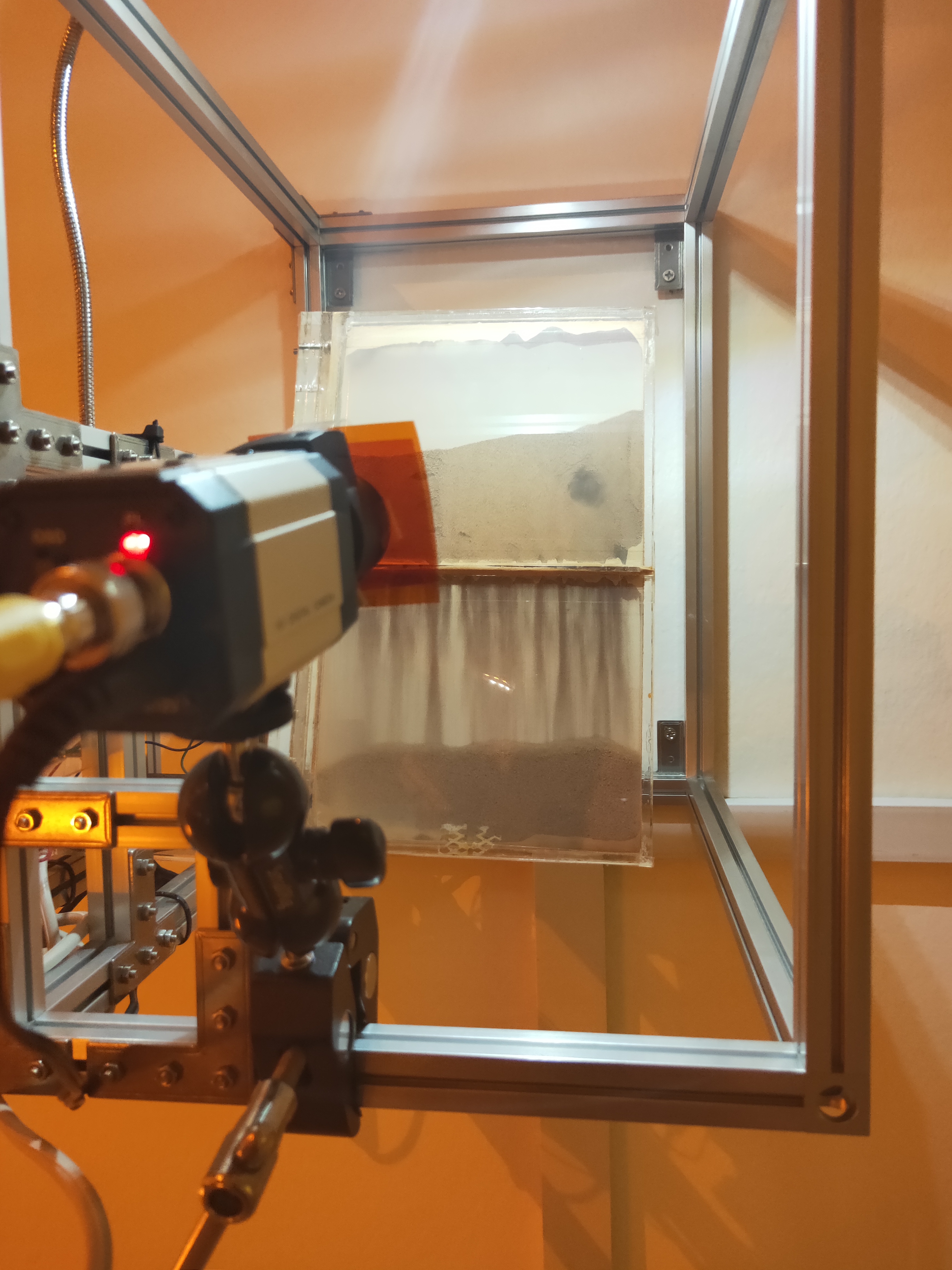 Debbie Ding, Sand Weight, 2018. Residual granite soil, LED strip, stepper motors, acrylic, aluminium profiles, micro-controller,miscellaneous electronic components, CCTV camera with varifocal lens and projection. Dimensions variable
Debbie Ding, Sand Weight, 2018. Residual granite soil, LED strip, stepper motors, acrylic, aluminium profiles, micro-controller,miscellaneous electronic components, CCTV camera with varifocal lens and projection. Dimensions variable
I was overwhelmed with the warm orange lighting in the space when I first entered, then I noticed the scraping sounds, of scooping sand, soil or even cement coming from behind Red Landscape. It was just that vaguely familiar crumbling and crunch of a metallic shovel against any of the mentioned materials, the sounds we usually do not give much thought to as we walk past such encounters, especially past construction sites. It was ironically the most prominent element in the space that stayed with me because it was different.
It was different because while the other parts of the installation were mostly visuals, one would not normally consider the sound of crunching soil. We would usually just think of soil in terms of colour, cleanliness issues, contents and form. The space and the works were able to bring that consideration further, into the arenas of sounds, smells and progressions or changes through time.
Home without a Shelter comprised four grungy figures standing side by side in a line illuminated from the back by anodised aluminium alloy light stands. Top Soil was granite soil on acrylic and wood; Sand Weight consisted of a small, mechanised structure performing an action while being recorded by a CCTV camera. The regular action was then projected, magnfied, onto the wall just next to it. Soil Column was the last part, with four transparent columns filling up with residual granite soil and water.
It could have been the lighting and the lack of human presence, but it made me feel this strange combination of calmness, eerie presage, isolation and silence associated with post- apocalyptic imagery. The first parts of the installation seemed void of life, abandoned even, whereas the later parts seemed like a reintroduction, an intentionally orderly and guarded observation of samples.
sft crsh ctrl by Weixin Quek Chong was the next installation which was awarded the Grand Prize. The installation explored surfaces, materiality, form and transformation with various elements in the space. The audio-visuals, which resembled the popular ASMR videos we see on social media recently, were played on small digital screens that were juxtaposed with and against different materials within the whole installation.
Drapes of different materials were suspended from the ceiling and over frames, giving off varying sensory notions. The individual components were interesting to note both wholly and individually, each of them an invitation to think about the texture and surfaces, reflecting upon materiality as we know it versus how we were perceiving them within the space though conception of the human senses.
What I found the most interesting was that the installation explored materials that I would have expected it to be a deliberate selection on account they were physically sensorial, until I read that the artist wanted to elicit a perception of uncertainty and idea of non-occurrence. It was then that the installation made sense to me. The visitors might have been familiar with the materials, but to view them in different forms, positions, lights and mediums, does make one rethink what they know of the material previously. The installation’s components
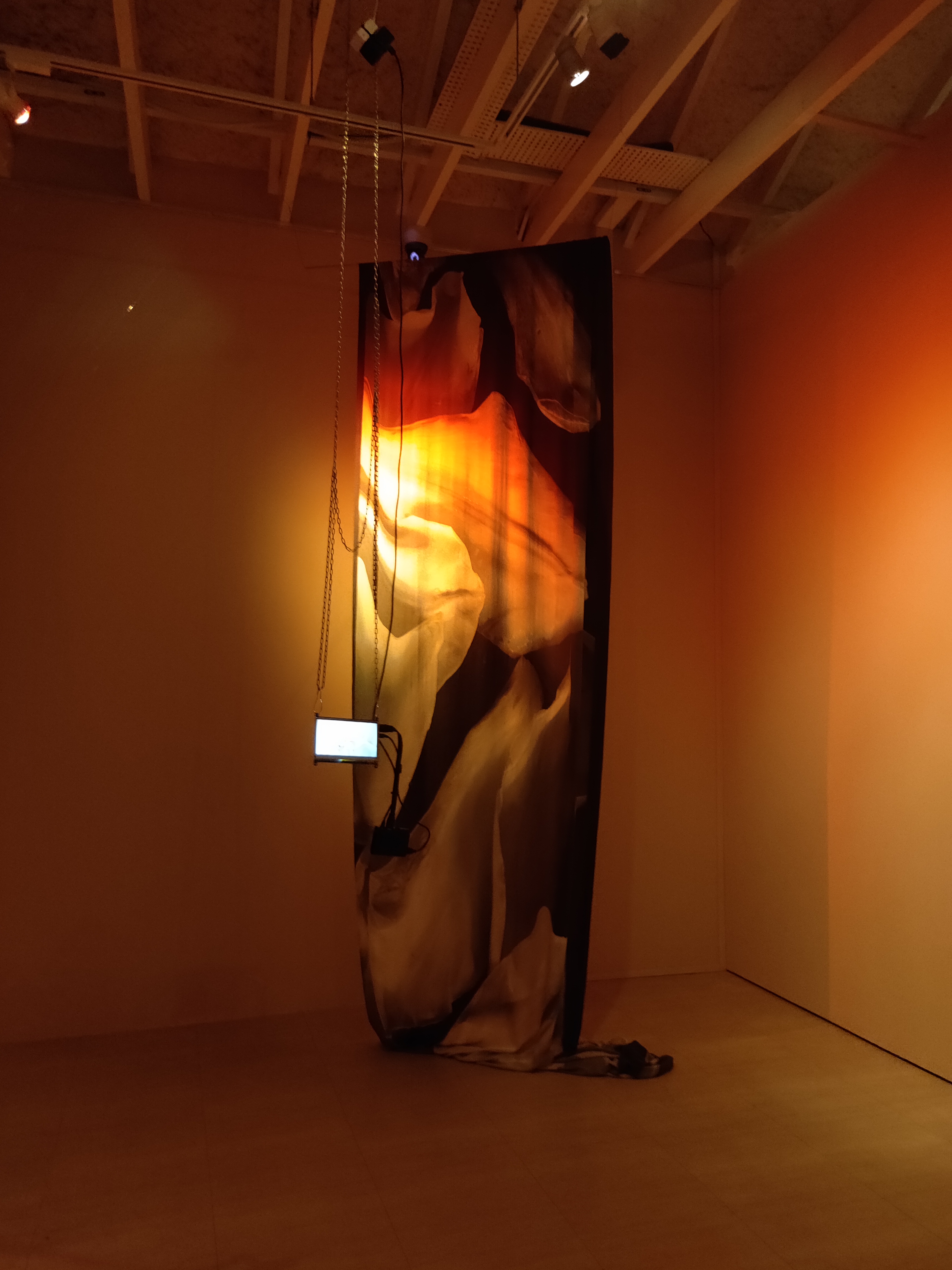 Weixin Quek Chong, Sft crsh ctrl, 2018. Silk twill, latex, wood,silicone, vinyl, faux fur, paper, screens, aluminium and stainless steel. Dimensions variable
Weixin Quek Chong, Sft crsh ctrl, 2018. Silk twill, latex, wood,silicone, vinyl, faux fur, paper, screens, aluminium and stainless steel. Dimensions variable
created a sort of rift between both memory and reality, making one try to recall distinctively the properties of each material and how they behaved under different treatments but end up a little confused about what their memory of the material was.
The last installation was An Exposition by the National Arts Council (NAC)’s Young Artist Award Winner, Hilmi Johandi. To me, his works had the greatest variation in terms of medium and form, from sculptural works to paintings to videos.
I understand that the works were supposed to engage the local history and collective memory of olden Singapore, and I think it was a theme that is different in the local contemporary art scene, whereby many would be addressing the more long- term yet still currently relatable ideas and issues such as identity and sexuality. It was a personal take on the artist’s own interests in memories and the local cultural history that made his works relatable to his generation and those before him.
The idea of collective memory and local history seems unique to me, because there are multiple ways of perceiving the same things, whilst history and memory archival are subjective to individuals as well. It is a multifaceted notion, but for the artist to present a common ground that evokes distinctive memories of the past and creates a topic for dialogue, I think is a great accomplishment.
Reflection, thought and identity. This exhibition gave me some degree of reflexivity, the spaces I find myself in, to reconsider what I think I knew and what made me realise that the idea of identity is not exclusive to humans or living things, and identity may not necessarily be defined by specifics. What we see and know may not always be complete nor wholly right, but to some extent, it contributes to a collective experience that is irreplaceable and unique to ourselves.

